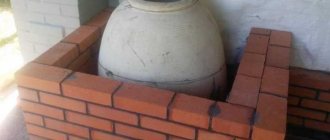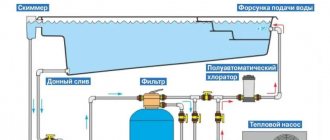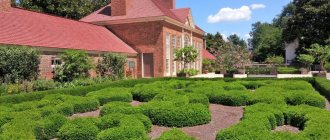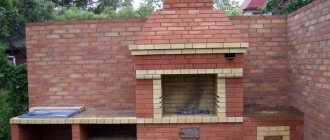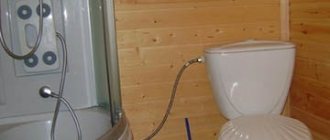Today, tandoors are bought mainly by those who have their own dachas, summer houses or country houses, since such a stove is installed in the yard, and the weight of stationary models (these are also used in restaurants and cafes with themed cuisine) can reach 1 ton. If you want to try real samsa, tandoori flatbreads, baked wings or chicken prepared according to traditional Asian recipes, you simply need a roasting oven, but it is not enough to go to the nearest store and buy the first tandoori that a consultant recommends to you. First, we advise you to carefully read this material: in it we will not only tell you how to choose the right tandoor, but also introduce you to some of the models that are most in demand in this category, and also tell you about the advantages and disadvantages of each of them.
What is tandoor
For Asian countries, the tandoor is the most common stove for cooking. Such a stove can be found in almost every home. Cooking food in it occurs thanks to the heated walls. The design of the tandoor allows it to heat up well even from a small amount of firewood and retain heat for a long time.
A tandoor oven is used to prepare a large number of dishes. Starting from traditional Uzbek bread flatbread, to cooking vegetables and meat.
Tandoor design
If you want to build such a stove at your dacha, then first let’s get acquainted with its structure.
The structure of the tandoor is very simple. The design consists of several elements:
- Tandoor.
- Thermal filler.
- Bricks.
- Blower.
- Lattice.
The entire furnace is laid out on a foundation. The height of the foundation is made from 30 to 40 cm, depending on the size of the stove. Half the height of the foundation is below ground level, the second is above. The traditional dimensions of a tandoor are 1-1.5 m in height. The width of the base is 1 m. The dimensions of the oven depend on the number of people for whom you want to cook food at the same time.
You might be interested in the article “Do-it-yourself greenhouse made from window frames: step-by-step instructions” Go>>
An important part of the tandoor is the inner liner. It is made from fireclay clay of medium viscosity and this work is very difficult. Today, you can use a ready-made clay insert to build a tandoor. In this case, building a stove will not take much time and anyone can cope with this task.
If you want to enjoy dishes cooked in a tandoor outdoors, you can purchase a ready-made oven. Manufacturers offer a wide range of stoves of any size and design.
Types and differences
There are several types of tandoors. Each has its own characteristics in operation and preparation. They can be classified according to several criteria:
By loading products
- Horizontal. It looks like a hemisphere or an egg. Weighs about 80 kg. Made from brick and clay, clay and wool. The stove is installed on a base 1 meter high from the floor. Products are placed horizontally. This type of tandoor is not as versatile as the vertical one in terms of the variety of products placed in it. It is larger than the vertical one and its operation is more difficult. In it you can cook tandoori-nan flatbreads, dishes from meat, vegetables and fish, on a baking sheet;
- Vertical. It comes in different sizes - from small (70–90 cm in diameter), for home use, to very large (120–130 cm in diameter), for production.
In this case, the width of the walls of a small tandoor should be at least 3.5 cm, and a large one - at least 4.5. Otherwise, its heat capacity will be low and it will cool quickly. They cook in it: samsa, bread, pork, lamb or chicken kebab, seafood, vegetables. In Uzbekistan, lamb meat is smoked for the national dish “kandir kabob”. Products are laid vertically.
By location
- Stationary. Applicable for both horizontal and vertical views. It is installed in the yard or in a catering kitchen as the main stove. In the past, when only stationary ovens were used, they did not know what a portable tandoor was.
- It is useful to know how to install a stationary tandoor. Before installing the fuel structure of a horizontal furnace type, prepare a brick or stone base. They install internal and external formwork and fill it with clay concrete. After the installed structure has dried, 7–10 days later, the kiln is fired. Then, the outer formwork is removed, the internal cracks are coated with clay, and the kiln is fired again;
- When making a vertical stationary tandoor, a mixture of kaolin clay and chopped wool is used. After giving the desired shape, the raw material dries. After drying, it is fired. Then, it is installed in its permanent location, covered with insulating and protective material, and fired again. After 7–10 days, after drying, the walls of the oven harden and become very durable.
- Portable. It is a jug with a narrowed neck and a wide bottom. Made from fireclay clay and wool. The neck of the case is closed with a two-level lid, small and large. The body is covered with horizontal and vertical forged metal rods for strengthening.
For easy carrying, there are two forged handles on the sides. At the bottom there is a built-in ash pan, designed to light the stove and, finally, remove the coals. The portable tandoor comes with additional elements: a device for simultaneous cooking of several products and for hanging skewers, skewers, grill mesh, baking sheets and racks, poultry attachments.
By fuel type
Wood-burning
Firewood is used in stationary, portable, horizontal and vertical tandoors. When using a new oven for the first time and during cold weather, the oven is heated gradually. First, kindle the wood chips and then add firewood at the rate of 2/3 of the oven volume (to effectively heat the chamber walls). Suitable wood for the stove: birch, oak, acacia, hornbeam (high heat transfer coefficient). It is not recommended to light the tandoor with wood from coniferous trees and fruit trees, due to the release of essential oils and resins, respectively, during the combustion process;
Electric
Portable type of oven, large and small sizes. The inner surface is ceramic, and the outer surface is metal. Designed for use at home, in cafes, restaurants - where it is not possible to use a coal stove. The food placed in it is cooked using electricity.
A built-in coil for a 220 or 380 volt tandoor is used. As a rule, a heating element with a voltage of 220 volts is intended for domestic use, and a heating element with a voltage of 380 volts is intended for industrial premises. You can cook shish kebab, samsa, and flatbreads in it. Remote control is used, due to which you can select the appropriate program;
Gas
A portable oven, often used in industrial settings, equipped with a gas burner. Convenient burners with a power of 24–60 kW, in which you can adjust the temperature.
Gas into such burners comes either from the main line or from a gas cylinder. In any case, for the burner to operate, air must be supplied to it. They use gas tandoor in cafes and restaurants, because the operation of such equipment is cheaper. Food cooked in electric and gas tandoors differs in taste from food cooked in a coal oven.
By country of origin
There are several other types of oriental stoves that are used in different countries. Each of these furnaces has its own history, so they can be called national.
The Armenian tandoor is used for cooking, heating the home and for medicinal purposes. Tonir, as it is called here, has been used in Armenia since the 2nd century. n. e. It is a stove lined with stone and installed below ground level.
Previously, the toner was installed in the house, now, most often, it is located on the street. Residents of Mountainous Karabakh use one tonir for several families, taking turns cooking food in it. Moreover, men are not allowed to participate in the process of making bread; women bake it.
The Azerbaijani tandoor is installed in the house or on the street. Tandoor is tendir in Azerbaijan. In this country it is used above ground and underground. In total, 4 types of Azerbaijani tendir are known: badly, doyme, stone and brick. Often used is badly tendir, which is installed in a hole, under the light and smoke hole. It produces the famous national flatbread tandyr-churek - an elongated oval shape, sprinkled with caraway seeds.
Turkish tandoor is made of brick. The Turkmen tandoor is made exclusively from ground clay. And they approach its production most carefully, using two techniques: sculpting and tape. The Georgian tandoor is used for baking national bread of different shapes: elongated and long - puri, round - matnakash, and oval - shoti.
The material from which the stove is made, in these countries, is traditionally clay with the addition of wool, or clay with the addition of crushed stone, or brick. Cooking techniques here have been brought to perfection, because masters have known what tandoor is since the Middle Ages. These stoves are installed here in houses and outdoors. They prepare meat, soups, flatbreads and other dishes.
Features of tandoor
An important feature of the stove is that it is not necessary to be near it while cooking. The principle of operation of a tandoor is that you only need to warm it up to the desired temperature. The oven retains heat for a long time, and food cooks evenly. Unlike a grill or barbecue, where you constantly have to monitor the cooking.
Uzbek
Tandoor appeared in Uzbekistan more than a thousand years ago. It was used for cooking and heating the house. It is made from kaolin clay. Sheep wool is added to the mixture. The shape is oval, the walls inside are smooth.
Cooking begins as soon as all the wood burns out. Their heat is enough for 3 hours of cooking.
If the tandoor is portable, then the walls are made a little thinner.
Armenian
The Armenian tandoor is distinguished by its spherical shape. Previously, it was very popular and was built in every yard.
Brick or clay is used in construction. The appearance resembles a cauldron turned upside down. Construction will require a lot of space. If you have free space, then this option will suit you.
You might be interested in the article “Floor in the garage: what is best to make it from, the pros and cons of 14 coating options” Go>>
The oven is heated well. Then they wipe off the burning and moisten with water for better adhesion of the bread cakes.
Accessories
A set of skewers and a grill will expand the range of possible dishes, and for the sake of new gastronomic sensations you should not refuse them.
Models with many holes at the bottom for air access that do not close after heating do not allow for heat retention and are not suitable for high-quality cooking.
Differences by installation type
There are several types of installation. It all depends on the size of the plot, the availability and quantity of building materials. If desired, portable tandoors can be taken with you into nature.
What kind of tandoor would you like to build (purchase)?
Zemlyanoy
As the name suggests, the entire structure of the furnace is located in the ground. This arrangement retains heat well. When choosing this option, take into account the groundwater level; if it is very high, then this placement should be abandoned.
There are two options for building such a tandoor:
- Having dug a hole of the required depth, we lay the bottom with fireclay bricks. The air duct pipe is installed. Next, lay out the flask, coat the gaps between the bricks well with clay. Two holes are made at the bottom of the stove for better fuel burning.
- The second option is simpler and faster. A ready-made clay tandoor is placed in the pit. Covered with earth.
Afterwards, the area around the stove is laid with tiles. The tandoor in the ground is heated from above. Thanks to good thermal insulation, the tandoor retains heat for a long time and can be used after preparing main dishes.
Ground (stationary)
The second option for building a tandoor is ground-based. To build such a tandoor, fire-resistant bricks are used. There are also clay tandoors - a classic tandoor for Central Asia. For construction you need to have special clay.
For above-ground tandoor, you can use a ready-made flask. This option is well suited for self-installation of the stove. Since the flask is the most important part of the tandoor and it is difficult to make it yourself.
To build a stationary tandoor, you must first prepare the foundation. Ready-made concrete slabs can be used as the foundation. We will tell you in more detail about the construction of a stationary tandoor later.
Portable (mobile)
The third option, which has become very popular today, is a portable or mobile tandoor. Today you can easily purchase such a stove in specialized stores or simply by ordering home delivery.
This oven is made of refractory clay and has metal handles for carrying. The oven lid consists of two parts. Making a portable tandoor with your own hands is difficult. It is necessary to have skills not only in pottery, but also to be able to forge iron.
You might be interested in the article “Distance from the stove to the hood: what you need to know for self-installation” Go>>
When choosing a portable tandoor, you need to focus on the volume of the jug. The larger the flask, the greater the number of dishes you can prepare. But do not forget that the weight of such a stove will also be large.
Must be stored in a protective case to protect it from drying out.
Horizontal tandoor
This design resembles a Russian stove. The oven has the shape of a hemisphere or a chicken egg located horizontally. Used for cooking fish, meat, vegetables on a baking sheet.
Installation of such a furnace is also carried out on a prepared foundation. It is usually built under a canopy. A chimney is not necessary for this option.
Fireclay bricks or clay are used as building materials. When installed using clay, the internal formwork burns out after the first firing; there is no need to remove it. Afterwards, the oven is coated again with a thin layer of clay.
Differences by fuel type
If you have a summer house or live in a house, you can afford a classic tandoor of any type of installation and use firewood for cooking. What about those who do not have such an opportunity? In this case, you can use electricity for heating.
The taste of cooked dishes greatly depends on the type of fuel.
From experience, where do the dishes taste better?
Gas
Natural gas is used to heat the walls of the oven in a gas tandoor. A gas burner is installed at the bottom of such a furnace. This option is perfect for catering establishments, bars, and restaurants.
The advantages of this type of heating are that it does not emit smoke and easily heats the oven walls to the required temperature. Easy to regulate and maintain temperature.
The downside, of course, is the taste of dishes that lack a slight smoky flavor. But despite this, they are very often used in the kitchens of restaurants and bars.
Electric tandoors
The oven is heated using an electric heating element located at the bottom. Thanks to the power regulator, you can set the desired temperature and maintain it for as long as you like. Like gas models, electric ones do not emit smoke or soot, so they can be used in an apartment.
Modern electric tandoor models have a screen and control buttons. Using such a device, you can monitor the readiness of a dish and control humidity.
Wood and coal
Such models are most similar to classic tandoor ovens. They are made from special fireproof clay and decorated with beautiful ornaments in oriental style. Metal hoops encircle the jug. Carrying handles are attached to them.
A small hole is made at the bottom for igniting and cleaning the stove. The lid is two-level, with special slots all around. They hold skewers for cooking meat, fish, and vegetables. Cooking begins as soon as all the wood is burned.
You may be interested in the article “Ventilation deflector: 7 popular models” Go>>
A wood-burning tandoor can be heated with charcoal.
The use of coal is not permitted!
Stages of building a brick tandoor
If you decide to make a tandoor with your own hands, then for this you will need:
- fire brick;
- fireclay clay;
- sand;
- stone or tiles for finishing.
The size of the oven depends on the number of dishes that need to be cooked.
Foundation
Tandoor production begins from the foundation. A concrete slab can be used as a foundation. If there is no such thing, then we fill a regular foundation.
The shape of the foundation can be round or square, but not much larger in size than the base of the furnace. Half of the foundation base is above ground level.
It is necessary to make a hole in the base to allow air to enter and ash to be cleaned. An ash pan is installed at the bottom.
Brickwork
The brick for the tandoor must be fireproof. The flask can be laid out in two ways:
- The bricks are laid horizontally. In this case, the consumption increases, but the heat capacity of the furnace will also be large and it retains heat for a long time. Well suited for the ground version.
- With vertical masonry, brick consumption will be minimal. But such an oven will also cool down faster. It is necessary to take care of thermal insulation. This masonry option is best used for an earthen tandoor.
When building a tandoor from fireclay bricks, templates are used. They help you maintain the correct form. You can use a soft metal hoop that is not very wide. When laying, it is moved upward, securing it to the previous row.
A wooden template is used inside, according to the size of the hearth. It is also moved upward as the brick is laid.
Reinforcement and coating
To prevent cracks from appearing inside the flask due to temperature changes, reinforcement is performed.
After the oven is lined, the inside is coated with a thin layer of refractory clay. Without letting it dry out, we place a light, easily shaped mesh inside. Pressing it into the clay, we apply another layer. The second layer must be carefully leveled.
The top of the bricks also needs to be coated with clay, or decorated with tiles or wild stone.
Depending on the size, the tandoor will dry out completely in a few weeks. There is no need to rush with the firebox; cracks may appear. It’s also not worth heating the stove right away. You need to start with a small amount of firewood.
How to choose a tandoor for your garden: what to look for when buying
If you decide to opt for a mobile product, you need to know the most important parameters of the fryer, which directly affect comfortable use.
Dimensions
Choosing a tandoor for a summer house begins with finding the optimal size:
- Small - a “camping” option, intended for cooking in the summer. The bottom diameter varies from 65 to 70 cm. The weight of such a roaster is no more than 50 kg.
- Average – bottom diameter is 90-100 cm. Weight reaches up to 100 kg. Can be used in winter. Good for a small family.
- Large – weighs up to 300 kg. Bottom diameter 110-130 cm. Designed for large companies or professional use.
Wall thickness
This indicator directly affects the heat capacity and the higher it is, the longer the heat remains inside the tandoor. For a small or medium-sized roaster, the thickness is 3-5 cm, for a large one - 6-9 cm.
Neck width
The optimal size of the neck width of a tandoor for a summer house starts from 30 cm. The wider it is, the more products can be cooked at a time.
Height
This indicator is considered one of the important ones, because if the height of the tandoor without a lid is half a meter, the products strung on the skewer will be cooked near hot coals, which can lead to burning. It is better to consider models from 80 cm in height.
Design and appearance
The product can be decorated with carved elements, stucco molding, mosaics and other decorative decorations that do not in any way affect the operation of the tandoor.
Lid opening mechanism
More modern models have a mechanism that locks the lid in the open position, which greatly simplifies the cooking process and eliminates the extra costs of purchasing a special stand.
Thermometer
For comfortable use, it is better to consider models equipped with a thermometer. It helps control the temperature of the air inside the fryer. To make the indicators more accurate, the thermometer is mounted in the lid.
Equipment
The standard equipment of the best tandoors for a summer residence should include:
- stainless steel skewers;
- the oven itself;
- large lid;
- small lid;
- crosshair - a device for hanging accessories and skewers under the lid;
- thick-walled grate;
- poker and scoop.
Some products come with a built-in or separate stand and a water-repellent cover.
Earth tandoor
The first tandoors built were earthen or pit tandoors. Such options are possible if the groundwater level is not high. Due to high humidity, the tandoor will not last long.
Depending on the size of the tandoor, one hole is dug for the stove, and the second for the pipe supplying air to the firewood. Sand is poured into the bottom of the pit to retain heat. Then the reinforced foundation is poured.
After the foundation has hardened, work can continue. The walls are laid out in the form of a jug using fireclay bricks. After the first row, an asbestos pipe is installed for air supply.
You may be interested in the article “How and with what to clean a washing machine: the best means, reliable and quick methods” Go>>
After the second row, grate bars are laid. Starting from the 7th - 8th row, the bricks are placed offset to form a jug shape. The throat should be half the size of the base.
The inner walls are coated with clay and leveled.
The distance between the walls of the furnace and the pit is filled with heat-insulating material.
How to use
In order to cook food in a tandoor, you need to follow all the steps sequentially. Instructions for using the oven:
- Place the oven (if portable type) on a flat, hard and durable surface.
- Remove the covers and open the blower.
- Before first use and when operating in cold weather, it is necessary to heat the stove with wood chips before loading firewood, in order to avoid cracks in the body.
- Place firewood inside the structure, 2/3 of the way, and set it on fire.
- During the combustion of wood, soot forms on the inner walls of the stove, which, as a result of combustion, falls to the bottom, which signals that the stove is ready to load the prepared products. The approximate heating time for the oven is 30–40 minutes. If the walls inside are ceramic, then they need to be wiped with a rag.
- After the firewood has burned out, you need to remove the coals or leave them a little.
- After loading the required amount of food, the body is covered with a two-level lid, the vent is closed, and the food begins to simmer. Meat and fish are hung vertically on skewers, bread is baked on the walls of a horizontal oven.
- Upon completion of cooking, the food can be removed, and the tandoor must be cooled in natural conditions.
- It should be stored in a dry and warm place.
Knowledge of how to properly heat a tandoor will help extend the life of this unique stove.
How to make a tandoor from a barrel
To build a tandoor with your own hands, a 200-liter metal barrel is perfect. The work sequence is as follows:
- Let's prepare the barrel. To do this, we cut off the top part and make a hole at the bottom for the blower.
- The walls inside can be finished with either brick or clay.
- Mix special fireproof clay with sheep wool, so the clay will not crack. Apply to the walls of the barrel in layers in a circle. Toward the top, the wall thickness should increase.
- If bricks are used for finishing, they are laid out with a minimum gap. For masonry, fireclay mortar or refractory clay is used. Upon completion, the entire oven is coated from the inside with clay 2-3 cm thick.
- The final stage of tandoor construction is making the lid. You can use metal 2-3 mm thick. A handle is attached to the lid.
After completion of construction, the furnace must be calcined 2-3 times. For this, a small number of small chips or branches are used. Before cooking, the walls of the oven are lubricated with oil.
On such an oven you can cook dishes within 5-6 hours.
Principle of operation
Read also: Place for a fire in the country: maintaining safety, maintaining ergonomics, creating comfort with your own hands (60+ Photos & Videos) + Reviews
Operating principle of a roasting oven
The essence of how a tandoor works is simple: natural, environmentally friendly fuel is placed inside: wood or coal . The heat from its combustion spreads through the clay insert, the walls of which maintain the desired temperature for a long time.
The heat in a heated oven usually reaches 250–350 degrees and remains at this level for up to 6 hours, after which the tandoor needs to be heated again.
The clay cauldron is lined with brick on the outside, and the space between the two shells is filled with thermal filler (salt, sand) to retain heat. At the bottom side there is a blower to form air draft and support combustion.
Kebabs and other dishes on skewers are placed over the smoke of an open tandoor fire, and flatbreads are cooked directly on the clay walls of the oven.
How to cook in tandoor
For many of us, tandoor is associated with cooking flatbreads and shish kebab. But this is not so; today a huge number of dishes are prepared in such an oven.
When cooking barbecue or pizza, you must use a grill. It is included in the additional kit when purchasing mobile oven options. It is secured to the neck and lowered into the middle of the tandoor.
The same grate can be used for cooking dishes in a cauldron. You can get wonderful pilaf or stew vegetables.
To cook fatty meat over coals, place a container on the grill where the fat will drain. These devices are used when preparing shurpa.
To prepare shish kebab or kibab, skewers are attached to special holes in the lid. Or hung on a metal rod. To maintain the temperature, everything is covered with a lid.
Tip: Place a pan with tough meat in an almost cooled tandoor. Cover the pan with a lid and leave it inside until the next morning. From this meat you can prepare any dish in which it will “melt” in your mouth.
All dishes are prepared much faster in the tandoor. Lamb - 18-25, beef - 30-35, fish -8-12, vegetables 5-7 minutes.
The history of tandoor ovens
Nature helped solve the problem of cooking in the hot conditions of Central Asia.
This area has a sunny, dry climate. In addition, in the countries of Central Asia there is a large amount of loess - a natural material that is stone dust, which is crushed to a powder. Central and Central Asia is considered to be the birthplace of tandoors . The first mention of tandoor dates back to the 11th century AD. It is no coincidence that tandoors appeared there. The shortage of fuel forced people to look for ways to cook food without using fuel due to the shortage of the latter. The solution was to bake a tandoor.
It is characterized by many unique properties:
- It is a heat-resistant and breathable material with high strength.
- Loess is a material with significant heat capacity and good heat transfer. This means that it heats up quickly, and it can give off heat for a long time.
- The process of processing loess is quite simple. And when it is wet, you can sculpt from it, as from ordinary plasticine.
It was this unique material that people in Central Asia used to make the first tandoors. Thanks to the dry, hot climate, the manufacturing technology of such stoves has been significantly simplified.
The first tandoors were earthen. They were arranged as follows:
A hole with a diameter of 50 cm and a depth of 35 cm was dug in the loess soil. An air duct was installed in the side part. Subsequently, the pits were made in the form of a jug, which ensured good fuel economy . This shape guaranteed a good concentration of heat in the center of the oven chamber.
, fireclay or kaolin clay is currently used . Its properties are similar to loess. When creating stoves, sand and chopped wool are added to the clay solution. This allows you to get a fairly thick solution.
The blanks made from this solution are left in the sun, under which they were exposed for two weeks. The conditions for low-temperature firing were created by intense heat and prevailing dry air. This is how Uzbek tandoors were made, which are now well known.
The tandoor is an oriental miracle structure with which you can prepare a wide variety of dishes - tasty and appetizing. Such stoves are created by craftsmen who use special clay, horsehair and quartz sand to make them.
The manufacture of the stove is done in a handicraft way, creating it in the shape of a cylinder with a narrowed neck . The usual wall thickness is 2 cm. When the tandoor structure is ready, it is dried in the sun for 7 days. Then the walls of the structure from the inside are coated with cotton oil. After this, the stove begins to be heated.
This process continues all day. This ensures good drying of the clay , as well as rapid heating of the walls of the kiln chamber. Subsequently, even after loading a small amount of fuel into the chamber, its walls will warm up in a short time.
The procedure of coating the walls of the tandoor with oil is also carried out so that after burning, the surface of the walls of this structure becomes smooth. When removing cakes from it, clay crumbs will not stick to their back side.
Tandoor: what it is and how it works
The operating principle of this stove is based on a combination of design features and the unique properties possessed by the loess material used to make such stoves.
A tandoor oven, heated from the inside, is usually made of loess or fireclay clay. These materials are characterized by high heat capacity.
Therefore, a heated oven releases heat evenly, providing optimal cooking conditions. When food is prepared in a tandoor, it is baked and not grilled over charcoal. In this respect, such a stove is similar to a Russian one.
When food is cooked on a grill, heating occurs unevenly, so it is necessary to constantly monitor the cooking process. In the tandoor, everything happens differently. Heat arises in the closed volume of the furnace from its heated walls. Therefore, food is heated evenly.
